

Damion Smy
2025 LDV Terron 9 review
22 Days Ago
The second-generation Navara Warrior, this time based on the PRO-4X, is the most capable factory version of Nissan's D23 dual-cab yet.



Senior Contributor
New from
$27,150
excl. on-roads

Senior Contributor
New from
$27,150
excl. on-roads


Senior Contributor
New from
$27,150
excl. on-roads

Senior Contributor
New from
$27,150
excl. on-roads
Quickly see how this car stacks up against its competition. Select any benchmark to see more details.
Where expert car reviews meet expert car buying – CarExpert gives you trusted advice, personalised service and real savings on your next new car.
The PRO-4X Warrior is dubbed “the world’s toughest Navara“, which is no small claim. What’s more interesting is that it’s a product spearheaded in Australia, for Australians.
Rather than watching Navara buyers drive up the road to ARB or any number of highly regarded aftermarket 4×4 accessory companies, Nissan wanted to offer a turnkey solution ready to go straight from the dealer. There’s money in modified utes…
Its first crack at something like this was the Navara N-TREK Warrior, the immediate predecessor to the PRO-4X Warrior. In both instances the variant label remained the same as the donor.

Once again the project is a collaboration between Nissan Australia and Melbourne engineering firm Premcar, known perhaps best for its fast Ford Falcons, and its Holy Grail package.
The Warrior program requires some 35 staff, including veterans from Holden and Ford. One, Mark Doody, has a near 40-year career working for Jaguar, Porsche and GM and was heavily involved in the VE Commodore.
A significant development phase and factory-line fitment of all the add-ons – many from the Nissan Genuine catalogue, but engineered to fit together cohesively – takes place in Melbourne’s northern suburb of Epping, before Warrior stock ships out to dealers.

We’re talking 40mm more clearance thanks to new springs and shocks, all-terrain tyres, underbody protection, a steel bullbar with a spot for a winch, a light bar, and side flares. And it’s covered by Nissan’s five-year warranty.
As well as bench testing, the Warrior was again tested on-road, as well as off the beaten path at Victorian sites such as the Australian Automotive Research Centre (AARC), the Toolangi forests, Narbethong, Walhalla and Big River.
That being the case, our launch drive instead took place near Coffs Harbour, in some beautiful dense forests with muddy, rutted trails everywhere. It was a challenging environment reflective of what should be this vehicle’s natural habitat.
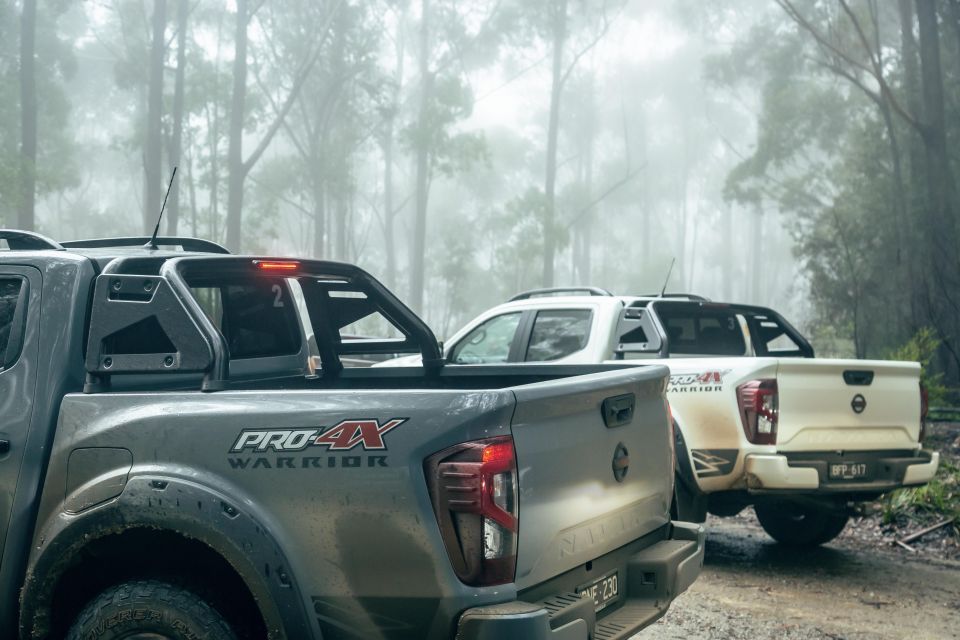
The PRO-4X Warrior is $9360 more expensive than the PRO-4X donor. It’s also $3700 more expensive than the old N-TREK Warrior derivative was.
All prices exclude on-road costs.
For some context, the Australian-engineered Toyota HiLux Rugged X is $70,750, the Ford Ranger FX4 Max is $66,190, the Mazda BT-50 Thunder is $68,990, and the Volkswagen Amarok W580S is $79,990 – these are all RRPs.
As we said earlier, there’s no lack of competitors in the Aussie-modified ute space, and most involve OEM (or OEM-standard) local engineering to greater or lesser degrees. Such are the demands Australia dual-cab buyers place on their machines.



Specific additions to the PRO-4X Warrior over the donor vehicle include:
Other headline features are just mirrored from the PRO-4X.


Outside
Inside

The Navara has a five-star safety rating based on ANCAP testing conducted in 2015.
That rating was based on a frontal offset score of 14.01 out of 16, a side impact score of 16 out of 16, and pedestrian and whiplash protection scores of Marginal and Good, respectively. All models come standard with seven airbags.
Standard active safety features added to the 2021 Navara update and carried over to the PRO-4X Warrior include:

There aren’t a lot of changes in here over the donor beyond some minor labelling/embroidery, and I have to say those OEM seats are ripe for replacement by something larger in the base, with more padding and better bolstering.
The Series 5 Navara’s cabin is largely familiar to anyone who’s sat in earlier iteration D23s, though the updated steering wheel is a far better design than the old car’s, where the horn was too close to the rim. There’s still no telescopic adjustment for the steering column however.
The large digitised trip computer is slick, and has a cool startup animation showing the car’s grille in all its newfound macho glory. It’s also simple to cycle through trip data, active safety functions, detailed direction signals when you’re using the navigation, and audio functions via the steering wheel buttons.


The centre touchscreen has a good sat-nav system that can be controlled from the screen or via the quite effective native voice control system. If you prefer you can use phone mirroring. The overhead view camera doesn’t have the crispest resolution but it’s still a worthy feature in such a large vehicle that makes tight parking easier.
Still, it looks pretty dated and pretty small now, and once the new Ranger lobs this gulf will widen.
Connectivity-wise you have Bluetooth or the choice of three regular USB points and a single USB-C. I had no complaints around the clarity of my voice on phone calls. There are also 12V outlets in the fascia and in the centre console, but no 230V like a Ford Ranger has.


The dual-zone climate control system is all operated by buttons so it’s quite user-friendly, ditto the simple switch to control your 4×4 modes, rear locking diff, parking sensors, and hill-descent control.
It’s all really solidly built, with no squeaking or rattling trims, and a properly bolted-in centre tunnel. The dash is covered in hard trims which are easy to clean, while touch points like the door armrests and centre console lid are squishy and cushioned.
There’s a shortage of storage up front, with just the one glovebox (HiLux and D-Max have two stacked atop each other), no dashtop storage, a small console, a shallow open cubby below the ventilation controls that’s frustratingly smaller than a phone, modest door bins (1L bottle friendly), and a sunglasses cubby.


Nissan has oddly removed the nifty pull-out cupholders that were mounted under the outboard front vents in older models.
The Navara has never had the most roomy back seats in the caper, though I’m 194cm and 105kg and can fit behind my own ideal seating position if need be.
Headroom and knee room is borderline for me but for most people will do the trick. A couple of kids or teenagers on family road trips should feel right at home.
Amenities back there include solid grab handles on the B-pillar, a folding armrest with cupholders, rear air vents (not all competitors have these), and a single USB point. Rear occupants also have side head-protecting airbags and a combination of ISOFIX anchors and a single top-tether loop.



The back-seat bases flip upwards and tether to the headrest, with two small storage cubbies below. This whole area is handy for when you wish to stow things in the cabin rather than the tub for greater security.
The manual tailgate assistance means it can be raised with a single finger if need be.
The tub comes with what feels to be a high quality plastic liner that is solidly screwed in and sealed off, plus four D-rings and those aforementioned Utili-Track movable tie-down anchors. The sliding back window completes the deal.


While Premcar says it could have done some engine tuning, the decision was made to leave it alone to keep pricing lower. So, it’s unchanged over the regular Navara.
The powertrain in question is a 2.3-litre diesel four-cylinder with two turbos that operate at different engine speeds. Outputs are 140kW at 3750rpm and 450Nm between 1500 and 2500rpm.
Transmissions to choose from are a six-speed manual or seven-speed auto.
The driveline is part-time 4×4 with low-range and a locking rear differential. The braked-trailer towing capacity remains 3.5 tonnes.
The Navara uses a claimed 8.1 litres per 100km on the combined cycle test, and has an 80L tank.
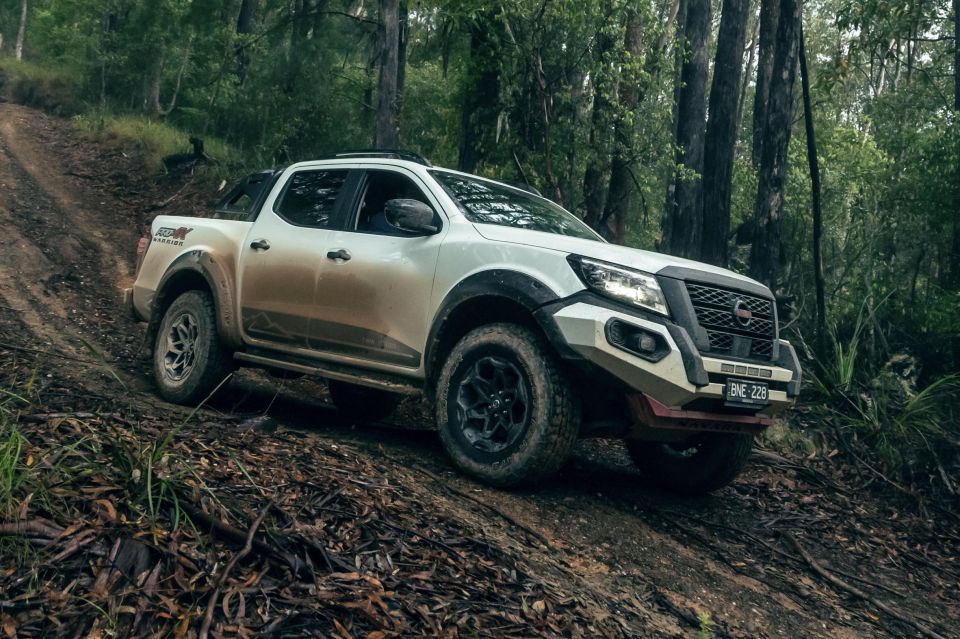
Where expert car reviews meet expert car buying – CarExpert gives you trusted advice, personalised service and real savings on your next new car.
The Warrior upgrade comes with a 40mm lift thanks to the bigger 275mm tyres, and updated springs (260mm total), a 30mm wider track, and 4-degree superior approach angle.
Premcar has reduced the front spring rates, while the two-stage rear coils have lower primary but higher secondary rates. The dampers are larger to disperse heat better and their rebound and compression characteristics have been thoroughly overhauled.
New front suspension jounce bumpers improve wheel movement control at high suspension travel and make energy transfer into chassis more efficient.
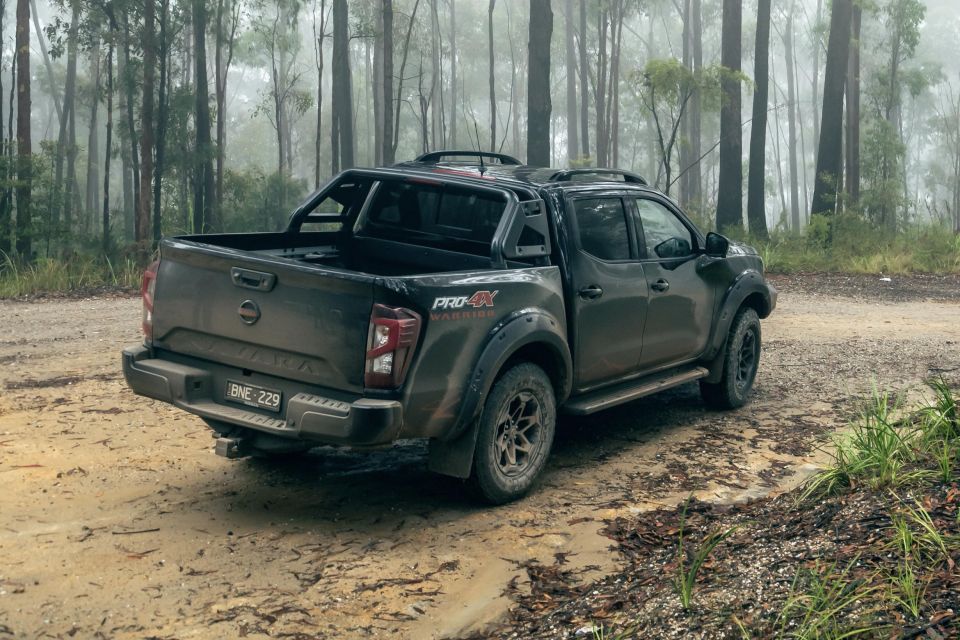
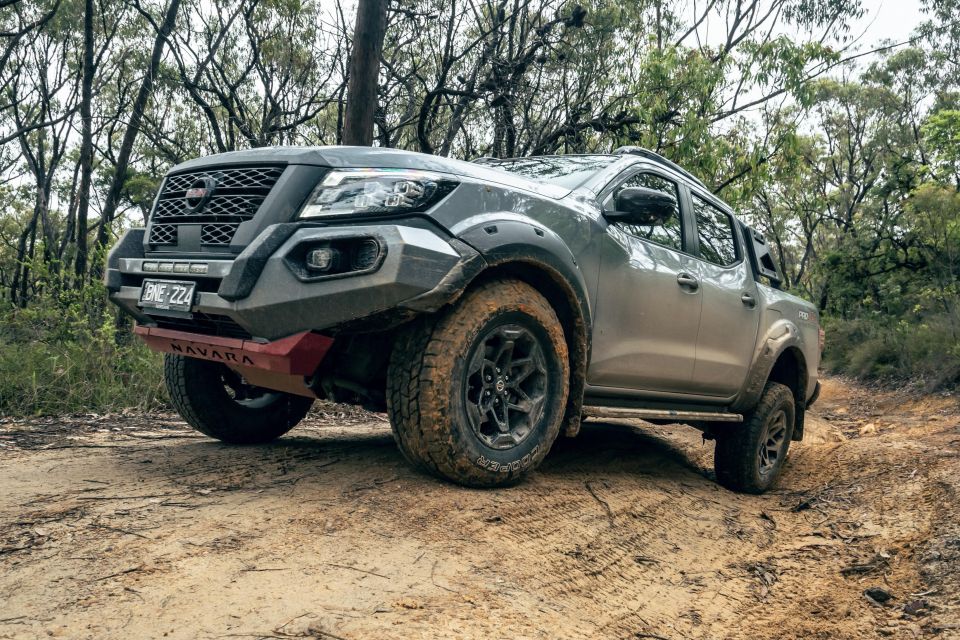
The main trade-off is reduced payload over the donor car (1004kg to 952kg for the auto), though this is higher than the N-TREK Warrior offered. The Series 5 Navara’s stronger OEM underbody allowed a GVM upgrade.
Then the mission is to make all these new bits talk to each other, because a bad tune would render the whole exercise pointless.
“While we were immensely proud of the N-TREK Warrior, there are always learnings and improvements to be made, and this new Warrior improves the formula right across the board,” claims Premcar’s head engineer Bernie Quinn.


“… We have done literally tens of thousands of kilometres at the AARC alone,” he added. “There’s a high-speed circuit, a noise-calibration surface, off-road tracks, durability circuits.
“The military uses it to ensure its vehicles are tough enough, and it was the perfect place to put the Warrior 2.0 through its paces.”
While the latest iteration Series 5 Navara is itself an improvement, the Warrior build unlocks more potential. The added clearance and far better frontal protection means you feel much more confident tackling steep terrain and dropping into deep ruts.

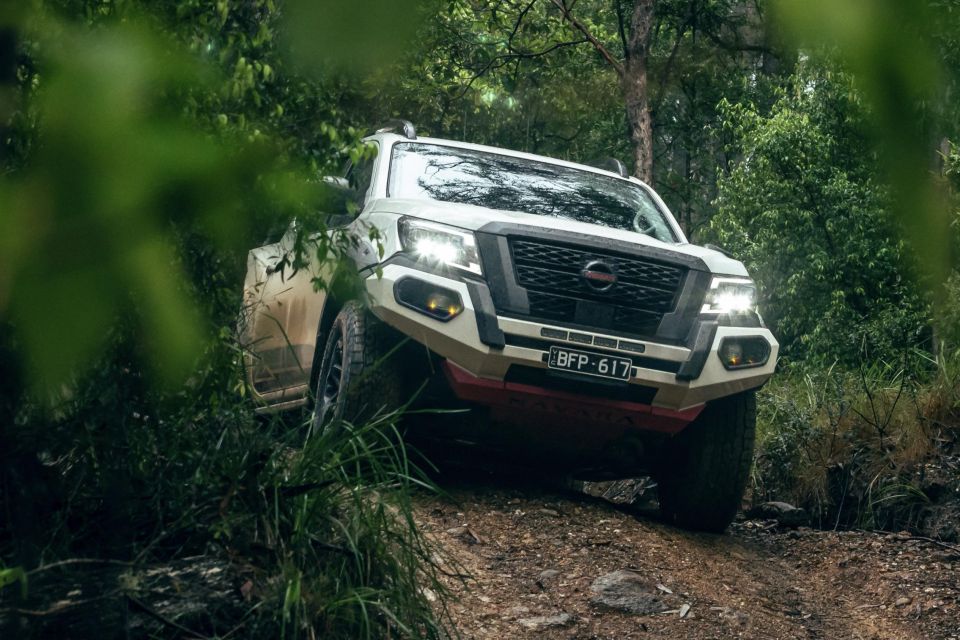
The spring and damper changes plus the chunkier tyres (heavier rubber too, but that’s addressed in the build) isolate you better from classic Aussie surfaces like prolonged corrugations or constant potholes, making it a more comfy daily.
Sometimes chunky tyres like this are loud over coarse-chip asphalt, but the base Navara has better NVH suppression than most and I didn’t find my highway stint at all unpleasant in the modified version.
In terms of off-roading, the Navara uses an old-school part-time 4×4 system that defaults to rear-drive on the road, with closed-centre-diff high range and then separate low-range gearing – assisted by a pretty effective automated descent control function.

That being said it happily crawled and snaked its way through our steep launch paths until the tyres were totally caked with clay and about as grippy as a bar of soap. I never needed to engage the rear diff lock, but there weren’t many offset steep drop-ins or things of that nature.
The steering feels weightier than more modern EPAS systems, but Nissan has removed some of that resistance and the positive side is greater feel for the terrain your tyres are tackling.
The add-ons do have a weight impost, with the Warrior’s kerb mass about 150kg greater – that solid steel front bar alone adds plenty of kg. So the lack of engine or brake updates show that the Warrior package had to meet commercial realities.
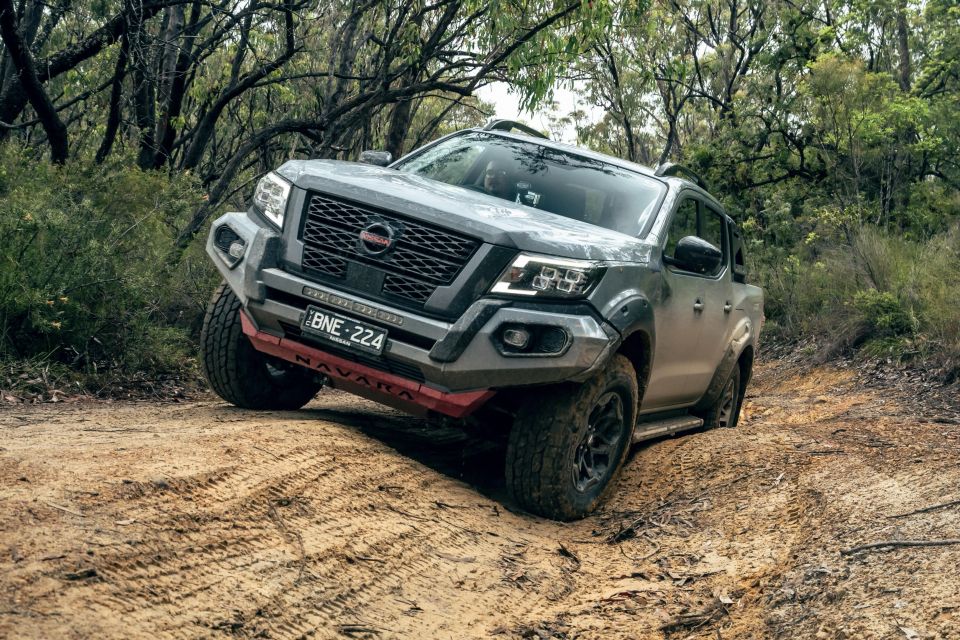
The twin-turbo diesel’s outputs are middling, and while it does get up and go when asked, it’s not capable of pushing you back into your seat like a V6 Amarok for example. It does the job, but if you were hoping for extra straight-line oomph you’ll be disappointed.
That seven-speed automatic is pretty refined and intuitive, and the upside is both strong refinement and better fuel economy than most – we’ll wait for an extended efficiency road loop to test the accuracy of the claim, though Navaras tend to be good on the dino juice.
Ultimately, plenty of 4×4-ers living the ‘Nav Life’ will want to consult their own aftermarket providers and oversee their build. But for those who don’t want to go through all that, the Warrior really does demonstrate a new, more capable side to the donor vehicle.


The Navara Pro-4X Warrior has a five-year, unlimited-kilometre warranty like the wider Nissan range.
Maintenance is required every 12 months or 20,000km, whichever comes first.
“… You’re supported, just like any other Navara owner would be,” says Nissan Australia’s senior manager of local product development and enhancement, Matt Baily.

There’s still scope for improvements, all of which Premcar could absolutely achieve if the business case stacked up: better seats and a bit more grunt come to mind.
However, that’s not to take-away that fact that this is a cohesively, thoughtfully modified offering, and probably the world’s best OEM-supplied Navara.
The PRO-4X model is a better starting point than the N-TREK Warrior was, and this program simply builds on it. And by supporting it, you also help Australian engineering too.

Click the images for the full gallery
MORE: Everything Nissan Navara
Where expert car reviews meet expert car buying – CarExpert gives you trusted advice, personalised service and real savings on your next new car.


Damion Smy
22 Days Ago


Josh Nevett
21 Days Ago


Paul Maric
20 Days Ago


William Stopford
20 Days Ago


William Stopford
17 Days Ago


Derek Fung
17 Days Ago